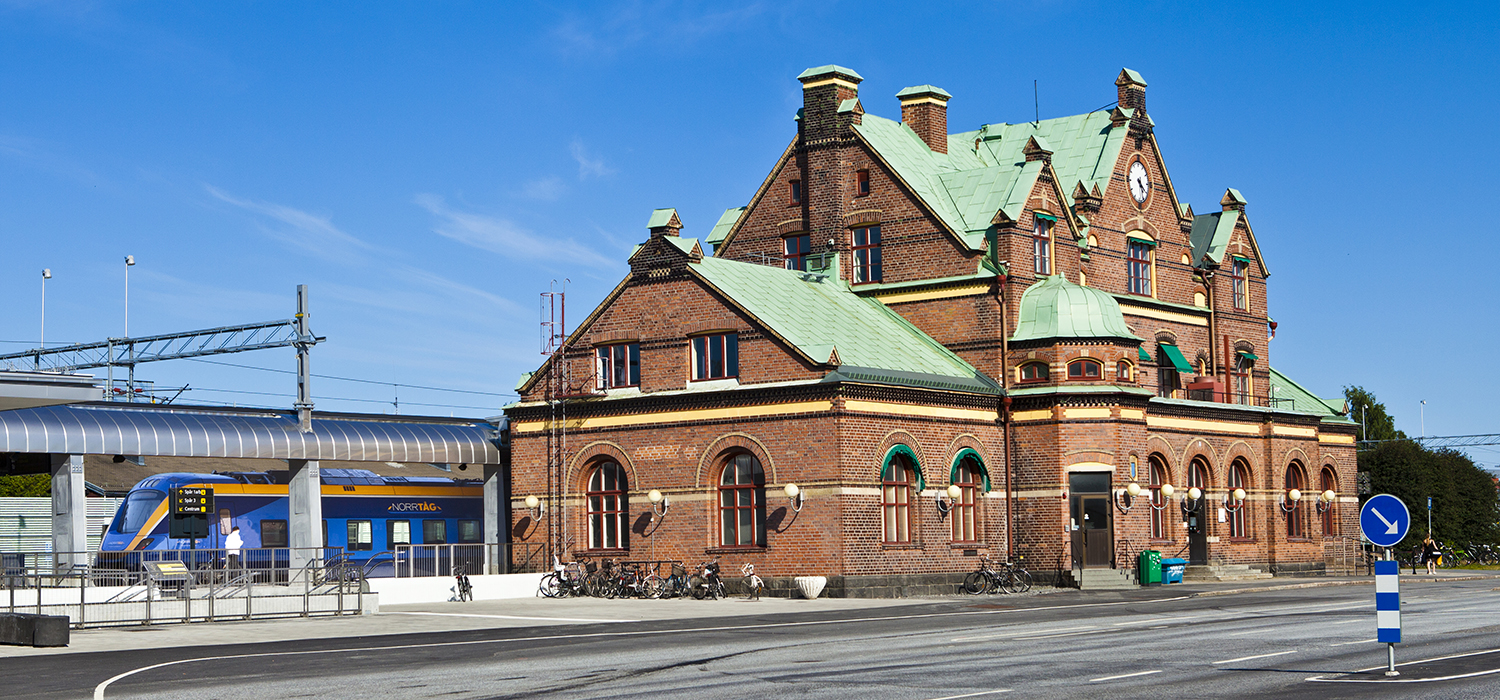
Umeå Central Station
A building with cultural-historical value

Umeå centralstation är belägen i centrala Umeå och bidrar tillsammans med Umeås andra stora nav för resande, Umeå Östra resecentrum, till ett hållbart resande i en växande region.
A listed building carefully restored
The station building was constructed in 1895-1896 and has now been declared a listed building. The architecture is typical of the period, but unlike contemporary station buildings, the station was built with a brick façade.
In recent years, the building has been carefully restored in consultation with building heritage experts to restore as much of its original character as possible.
INAB owns the station property and is responsible for the station’s day-to-day operation. The Swedish Transport Administration is responsible for maintaining the tracks and platforms.
Information for travellers is available at dinstation.se External link..
External link..
In brief
Year of construction
1896
Declared a listed building
2001

Umeå Central Station around 1950. Picture from jarnvagsmuseet.se, unknown photographer.
History of the railway
During the second half of the 19th century, the Swedish railway network was expanded on a large scale. Umeå became the last of the country’s residential towns to be connected to the Swedish mainline railway network. The station building was designed by the then chief architect Folke Zettervall, who designed railway stations for 40 years. With its monumental appearance, the architecture has similarities to the town hall, which stands as a counterpoint at the other end of Rådhusesplanaden.
The exterior of the station has remained relatively unchanged since its construction. However, the interior has undergone many transformations over the years. In connection with renovations in recent years, many of the interior changes have been restored to their original character.
The building is now one of about eighty listed buildings in Västerbotten. The station is considered to have significant cultural-historical value for Umeå’s cityscape and tells of the importance of the railway in the new Umeå/city that emerged after the city fire of 1888. The fact that the station is still used for its original purpose today reinforces its cultural-historical value.
The fact that the building is a listed building means that care and maintenance work that affects protected parts must be planned and carried out in consultation with the County Administrative Board and be done in such a way that the cultural-historical value is not reduced..
Contakt person
Current events
All current events-
 Projektledarkompetens med inriktning på infrastruktur hjälper Umeå att växa
Det kommunala bolaget INAB-Infrastruktur i Umeå AB arbetar på uppdrag av Umeå, för Umeå och den regionala nyttan. Inom Umeå kommunkoncern pågår flera projekt där Inab har tilldelats projektledarrollen och nya projekt är på gång där Inab kommer att involveras.
Projektledarkompetens med inriktning på infrastruktur hjälper Umeå att växa
Det kommunala bolaget INAB-Infrastruktur i Umeå AB arbetar på uppdrag av Umeå, för Umeå och den regionala nyttan. Inom Umeå kommunkoncern pågår flera projekt där Inab har tilldelats projektledarrollen och nya projekt är på gång där Inab kommer att involveras.
-
 Byggstart för Umeå hamns nya Energipir – en del i projekt Nordporten
Umeå Hamn AB har tecknat avtal med GRK för uppförandet av en ny Energipir, som är en del i en omfattande om- och utbyggnad av hamnen. Energipiren ingår i projekt Nordporten som inkluderar hela den inre hamnen. Arbetet påbörjas omgående och Energipiren planeras vara klar för drifttagning hösten 2027.
Byggstart för Umeå hamns nya Energipir – en del i projekt Nordporten
Umeå Hamn AB har tecknat avtal med GRK för uppförandet av en ny Energipir, som är en del i en omfattande om- och utbyggnad av hamnen. Energipiren ingår i projekt Nordporten som inkluderar hela den inre hamnen. Arbetet påbörjas omgående och Energipiren planeras vara klar för drifttagning hösten 2027.

